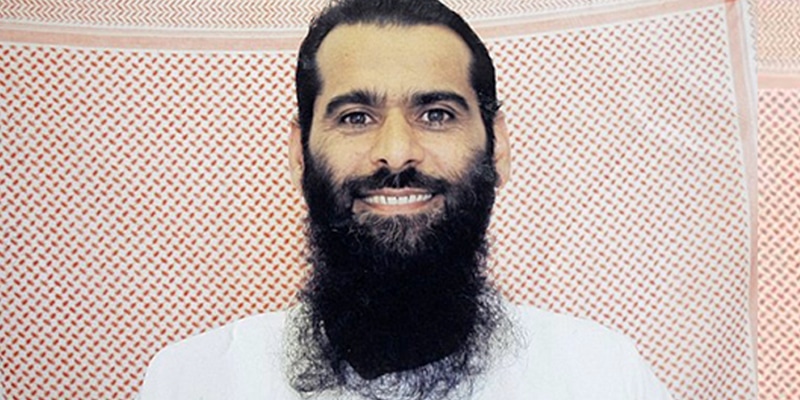“Forever Prisoner” Muhammad Rahim, the Last Afghan in Guantánamo, Eloquently Pleads For His Release

Please support my work as a reader-funded journalist! I’m currently trying to raise $2500 (£2000) to support my writing and campaigning on Guantánamo and related issues over the next three months. If you can help, please click on the button below to donate via PayPal.
On August 15, completely unremarked on by the mainstream media, Muhammad Rahim, the last Afghan held at Guantánamo, issued a heartfelt and eloquent plea for a panel of military and intelligence officers to approve his release from the prison, where he has been held for over 15 years without charge or trial.
Rahim, who is 57 years old, and in poor health, made his plea at a Periodic Review Board hearing, a process described by the media, when they can be bothered to pay attention to it, as a type of parole hearing — disregarding the crucial aspect that distinguishes it from parole hearings in the federal prison system, where the men given an opportunity to ask for their freedom have been convicted of a crime in federal court, and have received a prison sentence as a result.
Established under President Obama, the Periodic Review Boards were created to review the cases of men regarded as “too dangerous to release,” but against whom insufficient evidence existed to put them on trial — men accurately described as “forever prisoners.” Since November 2013, 58 men have been approved for release by PRBs, with 20 of those decisions taking place since President Biden took office (although most of those 20 men, shamefully, have not yet been freed).
The Broken Old Men of Guantánamo

Please support my work as a reader-funded journalist! I’m currently trying to raise $2500 (£2000) to support my writing and campaigning on Guantánamo and related issues over the next three months. If you can help, please click on the button below to donate via PayPal.
I wrote the following article for the “Close Guantánamo” website, which I established in January 2012, on the 10th anniversary of the opening of Guantánamo, with the US attorney Tom Wilner. Please join us — just an email address is required to be counted amongst those opposed to the ongoing existence of Guantánamo, and to receive updates of our activities by email.
In recent months, an often-submerged story at Guantánamo — of aging torture victims with increasingly complex medical requirements, trapped in a broken justice system, and of the US government’s inability to care for them adequately — has surfaced though a number of reports that are finally shining a light on the darkest aspects of a malignant 21-year experiment that, throughout this whole time, has regularly trawled the darkest recesses of American depravity.
Over the years, those of us who have devoted our energies to getting the prison at Guantánamo Bay closed have tended to focus on getting prisoners never charged with a crime released, because, since the Bush years, when, largely without meeting much resistance, George W. Bush released two-thirds of the 779 men and boys rounded up so haphazardly in the years following the 9/11 attacks and the US-led invasion of Afghanistan, getting prisoners out of Guantánamo has increasingly resembled getting blood out of a stone.
Apart from a brief period from 2008 to 2010, when the law finally reached Guantánamo through habeas corpus (before cynical appeals court judges took it away again), getting out of Guantánamo has involved overcoming government inertia (for several years under Obama) or open hostility (under Trump), repeated administrative review processes characterized by extreme caution regarding prisoners never charged with a crime, and against whom the supposed evidence is, to say the least, flimsy (which led to over 60 men being accurately described by the media as “forever prisoners”), and many dozens of cases in which, when finally approved for release because of this fundamental lack of evidence, the men in question have had to wait (often for years) for new homes to be found for them in third countries.
Completely Unnoticed, CIA Torture Victim Abu Faraj Al-Libi Has His Ongoing Imprisonment Without Charge or Trial Approved by a Guantánamo Review Board

Please support my work as a reader-funded journalist! I’m currently trying to raise $2500 (£2000) to support my writing and campaigning on Guantánamo and related issues over the next three months. If you can help, please click on the button below to donate via PayPal.
I wrote the following article for the “Close Guantánamo” website, which I established in January 2012, on the 10th anniversary of the opening of Guantánamo, with the US attorney Tom Wilner. Please join us — just an email address is required to be counted amongst those opposed to the ongoing existence of Guantánamo, and to receive updates of our activities by email.
On August 23, a Periodic Review Board at Guantánamo (an administrative, parole-type review process established by President Obama, featuring high-level US government officials) approved the ongoing imprisonment without charge or trial of Abu Faraj al-Libi, one of 14 “high-value detainees” who were brought to Guantánamo from CIA “black sites” in September 2006, and the last of the 14 to be captured.
Al-Libi’s hearing took place on June 23, and was the first time he had engaged with the PRB process since it was established in 2013. This ought to be have been newsworthy, but, in fairness, no media outlet could have been expected to know that he would finally deign to appear at the hearing, after refusing to take part in any previous opportunities to engage with the US authorities — or with the wider world.
However, it is a sad sign of the general lack of media interest in the shameful extra-judicial world of Guantánamo, where he has been held for 16 years without charge or trial, that only one media outlet — the New York Times — even bothered to find out what the board decided in his case after this first, momentous personal appearance, with veteran Guantánamo reporter Carol Rosenberg tweeting on August 29, “Just in: The Guantánamo review board has upheld the indefinite detention of the never charged former CIA prisoner called Abu Faraj al-Libi.”
The US’s Ongoing “Forever Prisoner” Problem at Guantánamo

Please support my work as a reader-funded journalist! I’m currently trying to raise $2500 (£2000) to support my writing and campaigning on Guantánamo and related issues over the next three months. If you can help, please click on the button below to donate via PayPal.
I wrote the following article for the “Close Guantánamo” website, which I established in January 2012, on the 10th anniversary of the opening of Guantánamo, with the US attorney Tom Wilner. Please join us — just an email address is required to be counted amongst those opposed to the ongoing existence of Guantánamo, and to receive updates of our activities by email.
It’s now over 20 years since, in response to the terrorist attacks on September 11, 2001, the Bush administration declared that it had the right to hold indefinitely, and without charge or trial, those seized in the “war on terror” that was launched after the attacks.
As a result of the US turning its back on laws and treaties designed to ensure that people can only be imprisoned if they are charged and put on trial, or held until the end of hostilities as prisoners of war, the men held in the prison at Guantánamo Bay have struggled to challenge the basis of their imprisonment.
For a brief period, from 2008 to 2010, the law actually counted at Guantánamo, after the Supreme Court ruled that the prisoners had constitutionally guaranteed habeas corpus rights, and 32 men were freed because judges ruled that the government had failed to establish — even with an extremely low evidentiary bar — that they had any meaningful connection to either Al-Qaeda or the Taliban. However, this brief triumph for the law came to an end when politically motivated appeals court judges passed a number of rulings that made successful habeas petitions unattainable.
No Escape from Guantánamo: Former Child Prisoner Boycotts Broken Review Process, Calls It “Hopeless”

Please support my work as a reader-funded journalist! I’m currently trying to raise $2500 (£2000) to support my writing and campaigning on Guantánamo and related issues over the next three months of the Trump administration. If you can help, please click on the button below to donate via PayPal.
I wrote the following article for the “Close Guantánamo” website, which I established in January 2012, on the 10th anniversary of the opening of Guantánamo, with the US attorney Tom Wilner. Please join us — just an email address is required to be counted amongst those opposed to the ongoing existence of Guantánamo, and to receive updates of our activities by email.
For the 40 men still held in the US prison at Guantánamo Bay, the wheels of justice have, fundamentally, ground to a halt under Donald Trump.
It’s now nearly ten years since a high-level government review process established by President Obama — the Guantánamo Review Task Force — issued its recommendations about what to do with the prisoners inherited from George W. Bush. The task force recommended that 156 men should be released, that 36 men should be prosecuted, and that 48 others should continue to be held without charge or trial — on the basis that they were regarded as “too dangerous to transfer but not feasible for prosecution” (a self-evidently dubious designation, as it accepted that there were fundamental problems with the so-called evidence used to establish these men’s guilt).
Throughout the rest of his presidency, Obama managed to release all but three of the 156 men that the task force recommended for release, but an evolving crisis in the military commission trial system (which basically involved convictions being overturned because the war crimes for which prisoners had been prosecuted were not internationally recognized war crimes, but had been invented by Congress), meant that half of those originally deemed eligible for prosecution were, instead, lumped in with the 48 men recommended for ongoing imprisonment without charge or trial.
Four “High-Value Detainees” Have Their Ongoing Imprisonment at Guantánamo Upheld by Periodic Review Boards
Please support my work! I’m currently trying to raise $2800 (£2100) to support my writing and campaigning on Guantánamo for the next three months.
On September 8, as I reported here, Hassan bin Attash, a former child prisoner and the younger brother of a “high-value detainee,” became the 64th and last prisoner to have his case considered by a Periodic Review Board. Set up in 2013 to review the cases of all the prisoners who are not facing trials (just ten men) or who had not already been approved for release by an earlier review process (2009’s Guantánamo Review Task Force), the PRBs began in November 2013, and function like parole boards. If prisoners can demonstrate contrition, and can also demonstrate that they bear no malice towards the US, and have coherent post-release work plans, and, preferably, supportive families, then they can be recommended for release.
Noticeably, of the 64 prisoners whose cases have been considered, 33 — over half —have had their release approved (and 20 of those have been freed), while 23 others have had their ongoing imprisonment approved. Eight decisions have yet to be taken. See my definitive Periodic Review Board list on the Close Guantánamo website for further details.
At the time of Hassan bin Attash’s PRB, just 19 men had had their ongoing imprisonment approved, but in the last three weeks four more decisions were announced — all decisions to continue holding the men whose cases had been reviewed. Fundamentally, this was not a surprise — the four men were all “high-value detainees,” men held and tortured in CIA “black sites” before their arrival at Guantánamo, and although seven HVDs have had PRBs, none have yet been approved from release (the three others are awaiting decisions). Read the rest of this entry »
Guantánamo “High-Value Detainee” Abu Faraj Al-Libi Seeks Release Via Periodic Review Board
 On August 16, Mustafa Faraj Muhammad Muhammad Mas’ud al-Jadid al-Uzaybi (ISN 10017), a Libyan prisoner in Guantánamo who is better known as Abu Faraj al-Libi, became the 59th prisoner to have his case reviewed by a Periodic Review Board.
On August 16, Mustafa Faraj Muhammad Muhammad Mas’ud al-Jadid al-Uzaybi (ISN 10017), a Libyan prisoner in Guantánamo who is better known as Abu Faraj al-Libi, became the 59th prisoner to have his case reviewed by a Periodic Review Board.
The PRBs — which include representatives of the Departments of State, Defense, Justice and Homeland Security, as well as the office of the Director of National Intelligence and the Office of the Joint Chiefs of Staff — were set up in 2013 to review the cases of all the prisoners who had not already been approved for release or were facing trials as a result of the recommendations made in reviews conducted in 2009 by another high-level government review process, the Guantánamo Review Task Force.
41 of the men judged to be eligible for PRBs were described by the task force as “too dangerous to release,” although the task force conceded that insufficient evidence existed to put them on trial, meaning that it was not evidence at all, but — and on this the task force was silent — generally untrustworthy information extracted from prisoners subjected to torture or other forms of abuse, or from prisoners bribed with the promise of better living conditions. Read the rest of this entry »
Plea Deals in Federal Court Mooted for Guantánamo Prisoners in Next Year’s National Defense Authorization Act
 I wrote the following article for the “Close Guantánamo” website, which I established in January 2012, on the 10th anniversary of the opening of Guantánamo, with the US attorney Tom Wilner. Please join us — just an email address is required to be counted amongst those opposed to the ongoing existence of Guantánamo, and to receive updates of our activities by email.
I wrote the following article for the “Close Guantánamo” website, which I established in January 2012, on the 10th anniversary of the opening of Guantánamo, with the US attorney Tom Wilner. Please join us — just an email address is required to be counted amongst those opposed to the ongoing existence of Guantánamo, and to receive updates of our activities by email.
Last week there was an interesting development in relation to President Obama’s hopes of closing Guantánamo, when the Senate Armed Services Committee announced that it had included a provision in its version of next year’s National Defense Authorization Act, which, as Charlie Savage reported for the New York Times, would allow Guantánamo prisoners to “plead guilty to criminal charges in civilian court via video teleconference,” and would also allow them to be “transferred to other countries to serve their sentences.”
Last November, a number of lawyers sent a letter to the Justice Department, which the New York Times discussed here, in which they “express[ed] interest in exploring plea deals by video teleconference — but only in civilian court, not military commissions.”
Lawyers for six prisoners said that they “may wish” to negotiate plea deals — Abu Zubaydah, the “high-value detainee” for whom the CIA’s torture program was developed, Abu Faraj al-Libi, another “high-value detainee,” Sanad al-Kazimi, a Yemeni who recently went before a Periodic Review Board, Abd al-Rahim Ghulam Rabbani, a Pakistani, Abdul Latif Nasser, the last Moroccan in the prison, and Soufian Barhoumi (aka Sufyian Barhoumi), an Algerian whose PRB is taking place on May 24. As Savage described it, the letter also “said several others are interested, and that Majid Khan, who has pleaded guilty in the [military] commissions system but has not been sentenced, would like to plead again, in civilian court.” Read the rest of this entry »
Presenting the First Annotated List of the 64 Guantánamo Prisoners Eligible for Periodic Review Boards
 I wrote the following article for the “Close Guantánamo” website, which I established in January 2012 with US attorney Tom Wilner. Please join us — just an email address is required to be counted amongst those opposed to the ongoing existence of Guantánamo, and to receive updates of our activities by email.
I wrote the following article for the “Close Guantánamo” website, which I established in January 2012 with US attorney Tom Wilner. Please join us — just an email address is required to be counted amongst those opposed to the ongoing existence of Guantánamo, and to receive updates of our activities by email.
Check out the list here.
On Monday, we published the first annotated list of the 64 Guantánamo prisoners eligible for Periodic Review Boards, which we hope will be useful to anyone who wants detailed information about who is still held at Guantánamo (also feel free to check out our full prisoner list here, listing all 107 men still held).
71 men were initially listed as eligible for Periodic Review Boards — 46 who were designated for ongoing imprisonment without charge or trial by the high-level, inter-agency Guantánamo Review Task Force that President Obama established shortly after taking office in 2009 (which issued its final report in January 2010), and 25 others who were recommended for prosecution by the task force, until the basis for prosecuting them — generally, charges of providing material support for terrorism — were struck down by the appeals court in Washington D.C. in two particular rulings in October 2012 and January 2013.
Of the 71, five were freed, and two others were reabsorbed into the ailing military commission system, leaving 64 men eligible for PRBs. 20 have had reviews since the PRBs began two years ago, with 15 approved for release (of whom four have been freed) and two others awaiting decisions, but 44 others are still awaiting reviews, and at the current rate it will take over four years — until sometime in 2020 — until they are all completed. Read the rest of this entry »
A Few Surprises in the New Guantánamo Prisoner List
 I wrote the following article for the “Close Guantánamo” website, which I established in January 2012 with US attorney Tom Wilner. Please join us — just an email address is required to be counted amongst those opposed to the ongoing existence of Guantánamo, and to receive updates of our activities by email.
I wrote the following article for the “Close Guantánamo” website, which I established in January 2012 with US attorney Tom Wilner. Please join us — just an email address is required to be counted amongst those opposed to the ongoing existence of Guantánamo, and to receive updates of our activities by email.
On February 20, my friend and colleague, the investigative journalist Jason Leopold, published a prisoner list from Guantánamo, which he had just obtained from the Pentagon, and which had not previously been made public.
The list, “71 Guantánamo Detalnees Determined Eligible to Receive a Periodic Review Board as of April 19, 2013,” identifies, by name, 71 of the 166 prisoners who were held at the time, and, as Jason explained in an accompanying article: Read the rest of this entry »













 Who's still at Guantánamo?
Who's still at Guantánamo?
